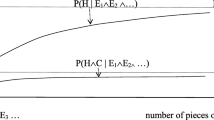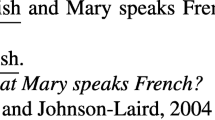Abstract
Crupi et al. (2008) offer a confirmation-theoretic, Bayesian account of the conjunction fallacy—an error in reasoning that occurs when subjects judge that Pr(h 1 & h 2|e) > Pr(h 1|e). They introduce three formal conditions that are satisfied by classical conjunction fallacy cases, and they show that these same conditions imply that h 1 & h 2 is confirmed by e to a greater extent than is h 1 alone. Consequently, they suggest that people are tracking this confirmation relation when they commit conjunction fallacies. I offer three experiments testing the merits of Crupi et al.’s account specifically and confirmation-theoretic accounts of the conjunction fallacy more generally. The results of Experiment 1 show that, although Crupi et al.’s conditions do seem to be causally linked to the conjunction fallacy, they are not necessary for it; there exist cases that do not meet their three conditions in which subjects still tend to commit the fallacy. The results of Experiments 2 and 3 show that Crupi et al.’s conditions, and those offered by other confirmation-theoretic accounts of the fallacy, are not sufficient for the fallacy either; there exist cases that meet all three of CFT’s conditions in which subjects do not tend to commit the fallacy. Additionally, these latter experiments show that such confirmation-theoretic conditions are at best only weakly causally relevant to the presence of the conjunction fallacy. Given these findings, CFT’s account specifically, and any general confirmation-theoretic account more broadly, falls short of offering a satisfying explanation of the presence of the conjunction fallacy.
Similar content being viewed by others
References
Carnap R. (1950) Logical foundations of probability. University of Chicago Press, Chicago
Christensen D. (1999) Measuring confirmation. Journal of Philosophy 96: 437–461
Crupi V., Fitelson B., Tentori K. (2008) Probability, confirmation, and the conjunction fallacy. Thinking and Reasoning 14: 182–199
Crupi V., Tentori K., Gonzalez M. (2007) On Bayesian measures of evidential support: theoretical and empirical issues. Philosophy of Science 74: 229–252
Eells E. (1982) Rational decision and causality. Cambridge University Press, Cambridge, UK
Fitelson B. (2001) A Bayesian account of independent evidence with applications. Philosophy of Science 68: S123–S140
Good I. J. (1950) Probability and the weighing of evidence. Griffin, London
Hertwig R., Chase V. M. (1998) Many reasons or just one. Thinking & Reasoning 4: 319–352
Joyce J. (1999) The foundations of causal decision theory. Cambridge University Press, Cambridge, UK
Keynes J. M. (1921) A treatise on probability. Macmillan, London
Lagnado D. A., Shanks D. R. (2002) Probability judgment in hierarchical learning. Cognition 83: 81–112
Levi I. (2004) Jaako Hintikka. Synthese 140: 37–41
Milne P. (1996) Log[p(h|eb)/p(h|b)] is the one true measure of confirmation. Philosophy of Science 63: 21–26
Sides A., Osherson D., Bonini N., Viale R. (2002) On the reality of the conjunction fallacy. Memory & Cognition 30: 191–198
Tversky A., Kahneman D. (1983) Extensional versus intuitive reasoning: The conjunction fallacy in probability judgment. Psychological Review 90: 293–315
Author information
Authors and Affiliations
Corresponding author
Rights and permissions
About this article
Cite this article
Schupbach, J.N. Is the conjunction fallacy tied to probabilistic confirmation?. Synthese 184, 13–27 (2012). https://doi.org/10.1007/s11229-009-9698-2
Received:
Accepted:
Published:
Issue Date:
DOI: https://doi.org/10.1007/s11229-009-9698-2




